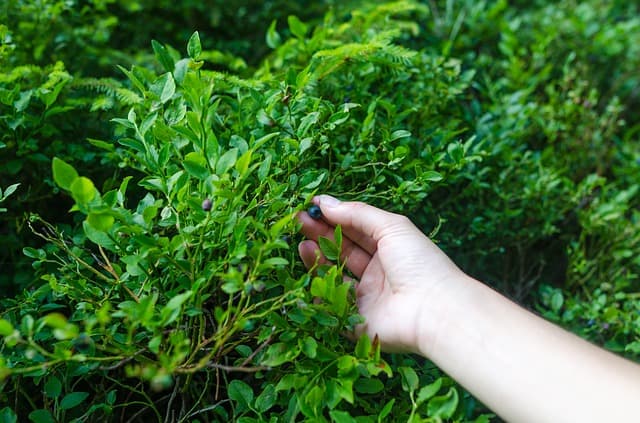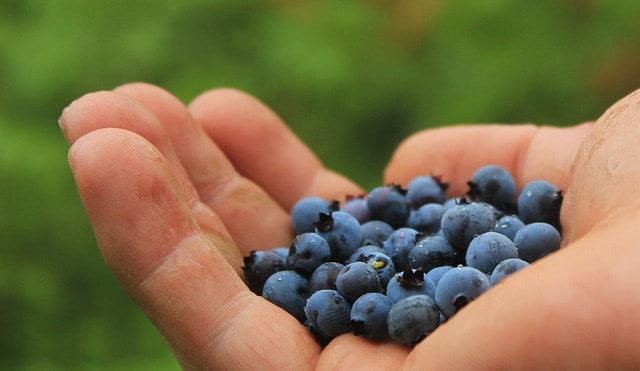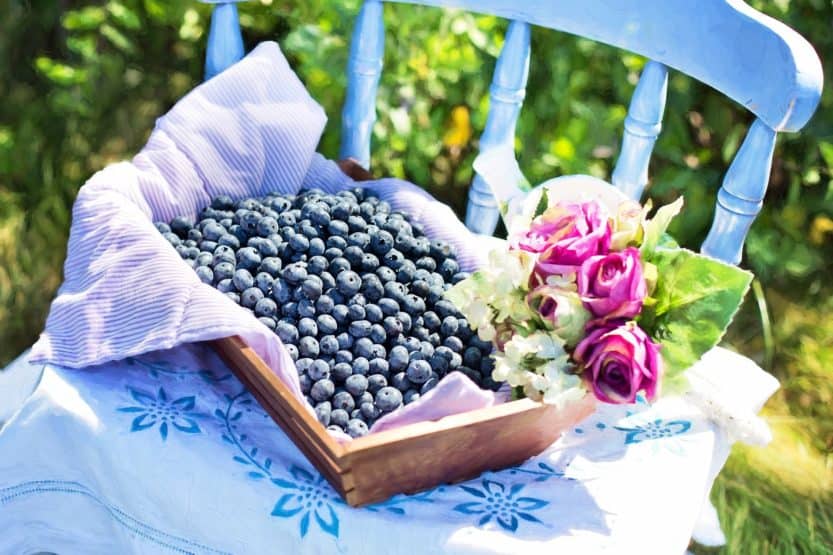Blueberries are a perfect fruit crop for small and large gardens alike, as these indigo-colored berries are rich in antioxidants and full of flavor. For the most part, the blueberry plant is easy to care for, as long as suitable soil conditions are present.
Blueberries prefer a very acidic soil, which is sometimes challenging to provide in some gardens; but the payoff of large sweet berries tends to make the small amount of extra, upfront work worth it in the long run. Another consideration is which variety to choose, so you can pick low-bush, high-bush or rabbit-eye.
Buy Blueberry Plants Online
| Image | Name | Rating | Shop |
|---|---|---|---|
 | Sunshine Blue Blueberry | ||
 | Patriot’ (HighBush Blueberry) | ||
 | Blueray Blueberry Plant | ||
 | Blueberry Plants “Legacy” Northern Highbush |
Highbush Blueberry vs Lowbush Blueberry
Low-bush blueberries do well in colder climates. As their name suggests, the low-bush blueberry tends to keep a more compact form and produce smaller berries; and they can reach a height of 6 to 18 inches (15 to 46 cm) tall and should be spaced 2 feet (0.6 m) apart. On the other hand, high-bush blueberries prefer a warmer climate and produce much larger berries. The high bush blueberry plants tend to reach a height of 6 to 8 feet (1.9 to 2.5 m) tall and should be spaced 6 feet (1.8 m) apart.
Rabbit Eye Blueberries
Rabbit-eye blueberries are well suited to very hot climates, with very low winter chill hours. They produce slightly smaller berries and tend to reach the height of 5 to 9 feet (1.5 to 3 m) and take up a lot of space, requiring a plant spacing of 15 feet (4.6m). Also, be sure to allocate enough space in your garden for multiple plants, because blueberries produce a much higher yield when cross-pollinated, versus being left alone to self-pollinate.
Planting Blueberries

Do Blueberries Need Full Sun?
When selecting a location to plant your blueberries, make sure it has full sun exposure for the majority of the day. Also, be sure to pick a spot that has soil that is well-drained, as standing water or a high water table will stunt or kill your plants.
Blueberry Soil Moisture
Even though blueberry plants do not like a poorly drained soil, the soil must hold sufficient moisture to produce a good crop. In most cases, adding peat moss to the soil can increase its water retention properties without affecting its drainage.
Blueberries Soil pH
The most important soil parameter for blueberries is pH, as they thrive in soil that has a pH between 4.1 and 5.0. For the most part, though, they do well in a pH range of 4.8 to 5.0, which tends to be a pH that most gardeners can provide with minimal effort.
Be sure to test your soil (Buy pH Tester Online), because the blueberry plant will be in this location for up to 25 years, and it’s worth the extra work to get an accurate gauge on the pH of your soil. If, as is usually the case in most gardens, your soil pH is above 5.0, then you can amend your soil with granular sulfur to decrease the pH.
Starting Blueberry Plants From Cuttings
Blueberry plants are usually found in most nurseries as 2 to 3-year-old plants. This helps speed up the time between planting and getting your first fruit yield. If you do choose to plant blueberries from seed, then you should be prepared to wait anywhere from 3 to 5 years before you get your first crop of berries from the plant.
How Deep Do You Plant Blueberry Bushes?
Assuming you purchased a plant, dig a hole as deep as the crown of your plant and 18 to 20 inches (46 to 51 cm) wide. Make sure to spread the roots out evenly in the hole and slowly push the soil back into the hole, while firming it with your hand as you go, being careful to keep the crown above the soil line.
Mulching Blueberries
After filling in the hole, you can add a 2 to 4 inch (5 to 10 cm) layer of mulch around the plant, in order to preserve moisture. Examples of good mulch materials are bark, sawdust, hay or pine needles. Water deeply after planting, in order to remove any air pockets left behind in the soil.
Blueberry Care and Feeding

Watering Blueberries
Be sure to provide your plants with 1 to 2 inches (2.5 to 5 cm) of water a week, and be careful not to over saturate the soil. During the first year, you can knock off all the flower blossoms from the plant, as this will help the plant send more energy to its young roots and provide a much larger harvest over the following years.
When Do You Prune Blueberry Bushes?

After the first year, prune the tree regularly by removing any dead or diseased growth and any branches that are crossing each other or are shaded in the interior of the bush. Fertilize your blueberries annually, and the best time of year to apply fertilizer is in the early spring when the plants are coming out of dormancy.
When to Fertilize Blueberries
Another light application of fertilizer can be applied in the late spring, once the plant’s leaves are fully formed, giving the plant a small boost as it prepares to produce fruit. Every two years, retest your soil’s pH, in order to make sure it is staying at least in the range of 4.8 to 5.0.
When Do You Harvest Blueberries?

Harvest time for most blueberries is usually between late July and early August, although climate conditions and rainfall can sometimes affect this time window. Around that time, you can start looking for berries that are showing signs of ripeness. You will see the berries changing from a reddish-purple to a sky-blue. They will also begin to soften to the touch; and, sometimes, a light pinch can help determine ripeness.
How to Harvest Blueberries
Ripe berries should almost fall off the branch with minimal effort, so if you have to pull on or bend the branch to remove a berry, it’s best to give it more time to ripen. You will have some competition for your harvest because birds are quite fond of blueberries. If this is the case in your area, you can buy netting or other bird deterrents for your plants, in order to keep the birds away from your berries. Once you harvest your blueberries, they will keep for about a week in the refrigerator. Freezing them or making jams, jellies or juice will provide a more long-term storage option.






